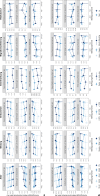[Subjective health in the early phase of the COVID-19 pandemic-a comparison of socio-demographic groups and pandemic-related risk factors]
- PMID: 38789544
- PMCID: PMC11231003
- DOI: 10.1007/s00103-024-03889-3
[Subjective health in the early phase of the COVID-19 pandemic-a comparison of socio-demographic groups and pandemic-related risk factors]
Abstract
Background: In the early stages of the COVID-19 pandemic in 2020, daily life was significantly restricted due to the containment measures of the initial lockdown while SARS-CoV‑2 incidences remained relatively low. This study analyses socio-demographic and socio-economic groups in terms of changes in their subjective health during this phase.
Methods: Data from the Socio-Economic Panel (n = 14,856, March-July 2020) were used to estimate the relative frequency of self-reported good health, great worries about one's own health, and high life satisfaction of men and women stratified by age, education, income, migration history, pre-existing medical conditions, and high-risk occupation. The results were mutually adjusted using logistic regression, displayed on a monthly basis, and compared with the pre-pandemic period.
Results: Individuals of higher age, with lower education or income, and with pre-existing medical conditions reported positive health outcomes less frequently and worries more often. The differences between the subgroups remained largely stable compared to the pre-pandemic period. During the period of strongest restrictions due to infection-control measures, good health was reported less frequently by individuals with lower education or income compared to individuals with higher education or income.
Discussion: The impact of the early phase of the pandemic on subjective health and life satisfaction was low for the majority of the examined groups. Relative impairments were only identified for women in low socio-economic positions.
Zusammenfassung: HINTERGRUND: In der Frühphase der COVID-19-Pandemie im Jahr 2020 war der Alltag durch die Eindämmungsmaßnahmen des ersten Lockdowns vergleichsweise stark eingeschränkt, während die SARS-CoV-2-Inzidenzen noch gering ausfielen. Der vorliegende Beitrag analysiert soziodemografische und sozioökonomische Gruppen im Hinblick auf die Beeinträchtigung der subjektiven Gesundheit in dieser Phase.
Methoden: Daten der Hauptbefragung des Sozio-oekonomischen Panels (n = 14.856, März–Juli 2020) wurden verwendet, um die relative Häufigkeit selbstberichteter guter Gesundheit, großer Sorgen um die eigene Gesundheit und hoher Lebenszufriedenheit von Männern und Frauen stratifiziert nach Alter, Bildung, Einkommen, Migrationserfahrung, Vorerkrankungen und Risikoberufen zu schätzen. Die Ergebnisse wurden mittels logistischer Regressionen wechselseitig adjustiert und monatsweise dargestellt sowie mit der vorpandemischen Zeit verglichen.
Ergebnisse: Personen in höherem Alter, mit niedriger Bildung oder niedrigem Einkommen sowie mit Vorerkrankungen berichteten seltener positive Gesundheitsoutcomes und häufiger Sorgen. Die Unterschiede zwischen den Merkmalsgruppen blieben im Vergleich zur vorpandemischen Zeit weitgehend stabil. Personen mit niedriger Bildung oder niedrigem Einkommen berichteten im Vergleich zu Personen der mittleren und höheren Bildungs- beziehungsweise Einkommensgruppen zum Zeitpunkt der stärksten Einschränkungen durch Infektionsschutzmaßnahmen seltener eine gute Gesundheit.
Diskussion: Der Einfluss der Frühphase der Pandemie auf die subjektive Gesundheit und Lebenszufriedenheit ist für den Großteil der untersuchten Gruppen gering. Nur für Frauen in niedrigen sozioökonomischen Positionen konnten relative Verschlechterungen identifiziert werden.
Keywords: Coronavirus; Lockdown; Pre-existing conditions; Self-rated health; Socioeconomic inequality.
© 2024. The Author(s).
Figures

Similar articles
-
Regional COVID-19 measures and effects on subjective well-being in Germany: observing trends over time with data from a large population survey.Front Public Health. 2025 Feb 27;13:1523691. doi: 10.3389/fpubh.2025.1523691. eCollection 2025. Front Public Health. 2025. PMID: 40084213 Free PMC article.
-
[People with a history of migration in the COVID-19 pandemic : Associations between life satisfaction and indirect socioeconomic effects of the pandemic].Bundesgesundheitsblatt Gesundheitsforschung Gesundheitsschutz. 2023 Aug;66(8):901-910. doi: 10.1007/s00103-023-03741-0. Epub 2023 Jul 20. Bundesgesundheitsblatt Gesundheitsforschung Gesundheitsschutz. 2023. PMID: 37474794 Free PMC article. German.
-
SARS-CoV-2 pandemic and Construction Industry: insights from Italian data.Acta Biomed. 2022 Jul 1;93(3):e2022233. doi: 10.23750/abm.v93i3.12265. Acta Biomed. 2022. PMID: 35775779 Free PMC article.
-
Loneliness during a strict lockdown: Trajectories and predictors during the COVID-19 pandemic in 38,217 United Kingdom adults.Soc Sci Med. 2020 Nov;265:113521. doi: 10.1016/j.socscimed.2020.113521. Epub 2020 Nov 12. Soc Sci Med. 2020. PMID: 33257177 Free PMC article.
-
Travel-related control measures to contain the COVID-19 pandemic: a rapid review.Cochrane Database Syst Rev. 2020 Oct 5;10:CD013717. doi: 10.1002/14651858.CD013717. Cochrane Database Syst Rev. 2020. Update in: Cochrane Database Syst Rev. 2021 Mar 25;3:CD013717. doi: 10.1002/14651858.CD013717.pub2. PMID: 33502002 Updated.
Cited by
-
Regional COVID-19 measures and effects on subjective well-being in Germany: observing trends over time with data from a large population survey.Front Public Health. 2025 Feb 27;13:1523691. doi: 10.3389/fpubh.2025.1523691. eCollection 2025. Front Public Health. 2025. PMID: 40084213 Free PMC article.
References
-
- Wachtler B, Michalski N, Nowossadeck E, et al. Sozioökonomische Ungleichheit im Infektionsrisiko mit SARS-CoV-2 – Erste Ergebnisse einer Analyse der Meldedaten für Deutschland. J Health Monit. 2020;S7:19–31. doi: 10.25646/7056. - DOI
-
- Schilling J, Buda S, Fischer M, et al. Retrospektive Phaseneinteilung der COVID-19-Pandemie in Deutschland bis Februar 2021. Epid Bull. 2021 doi: 10.25646/8149. - DOI
Publication types
MeSH terms
LinkOut - more resources
Full Text Sources
Medical
Miscellaneous

